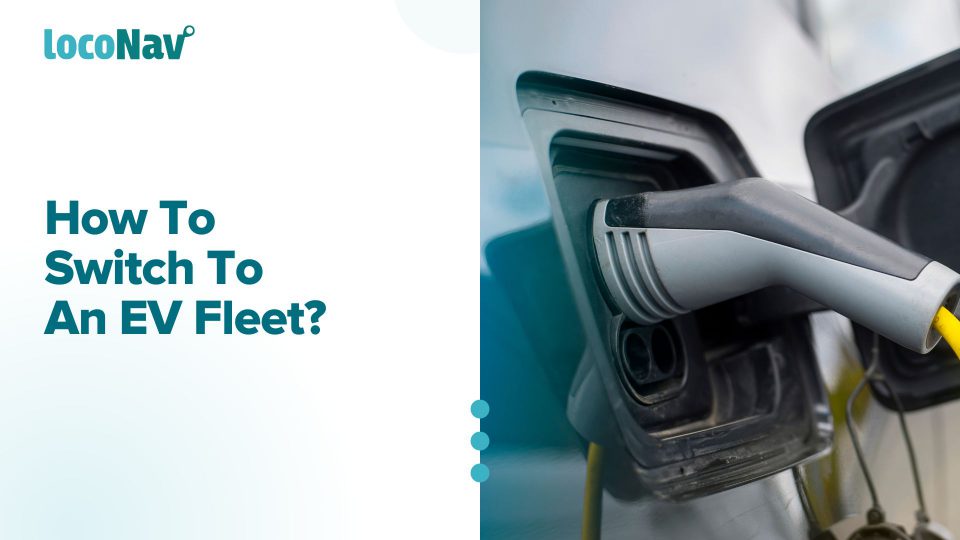

With numerous government entities attempting to eliminate ICE vehicles, switching to a green fleet has now become an unavoidable reality. This implies that fleet operators must plan for the creation of a new electric fleet.
The question then becomes, what comes next for fleet owners? How will they deal with all of the problems that this transition will bring, and what critical elements should be considered in the process to reap all of the considerable environmental, economical, and operational benefits that come with turning electric?
This blog will walk you through some recommendations to assist you in electrifying your fleet and making the transition easier.
Manage your fleet efficiently with LocoNav’s Fleet Management Solutions!
Why Should You Adapt To EV Fleet?
In recent years, many organisations’ priorities have altered, with sustainability rising to the top of the list. Making a concerted effort to cut business carbon pollution and become more ecological has progressed from a consideration to a must for every organisation.
For those who have yet to make the leap, consider the following three factors:
- Reduce Carbon Footprint
It’s no surprise that vehicle emissions are one of the leading causes of air pollution. Making the conversion to EVs can significantly reduce your company’s corporate carbon footprint and ensure your company supports the transition to a low-carbon future.
- Save Costs
Switching to an electric fleet results in huge cost reductions. Reduced maintenance and operating costs, as well as government assistance to help manage expenditures, are just a few examples.
EVs are often less expensive to operate since there are fewer moving parts that require maintenance, leading to less wear and tear over time.
- Convenience
There is an increasing number of creative fleet solutions available to assist companies with their EV transition.
For example, payment gateway technologies alter the way organisations manage expenditures for charging their EV fleets.
These solutions provide simplicity for both fleet managers and drivers by combining data from numerous sources, eliminating the requirement for driver reimbursement and allowing you to quickly track when your drivers charge and what they use.
Follow These Tips to Make Your Transition to an EV Fleet Smoother
- Gather Information
Collect as much information as possible ahead of time. More specifically,
- Goals for company sustainability and electrification
- A list of current ICE vehicles
- Specific fleet vehicle desires and requirements, for example, The vehicle’s functionality,
Gathering information is essential before building the EV fleet evaluation. Setting goals early on will result in a more efficient approach in the long run.
- Choose The Right Pace
To build and expand an electric fleet, you must find a middle ground between sustainability and business objectives. This is why it is critical to examine the capacity and requirements of your present fleet, as this will give you critical information for rolling out your new EV fleet.
The first step in identifying the optimal pace for your fleet’s development is to answer key questions such as: What types of EVs are now available, and which ones are comparable to the vehicles in your fleet?
- Communicate With Your Local Electricity Supplier
Check with your local provider to see if they can assist with a site evaluation, EV charger cost estimates, and information on electricity supply upgrades for your final report.
Contact them as soon as possible in the process. The charging infrastructure is crucial for fleet electrification. Internal engineers at your local utility can advise you on the price of service modifications to prepare for potential future electrification ambitions. If your utility does not provide these services, they frequently collaborate with reputable energy consultants that can assist with a fleet electrification analysis.
- Hire An EV Expert
If your local electricity provider does not conduct EV assessments, look for a local specialist who can help you develop a fleet electrification strategy. Energy corporations and non-profit organisations specialise in fleet electrification audits.
To effectively finish your company’s fleet electrification plan, you will need the assistance of an expert with the necessary contacts. Their knowledge will lead the next stages in electrifying your fleet and developing a strategy for moving forward.
- Future Proof Your Infrastructure
Utility service modifications are frequently required, based on the scale of a fleet. This often entails a transformer update, which can be costly. However, it is worthwhile to plan for the future by appropriately designing your transformer to support an all-electric fleet.
To be ready for a fully electric fleet, you must have enough electrical service capacity to meet all of your charging requirements.
- Understand And Avoid Range Anxiety
Most future EV fleet owners are currently concerned about when their vehicle’s battery will run out. Driving routes are not as straightforward to plan as they are with an ICE vehicle.
Plan trips or deliveries so that you may refuel your EV or find a charging station along the way. When fleet vehicles are parked overnight, it is best to recharge them. Consider rotating EVs for vehicles with limited downtime so that each can have a charging rest.
Final Thoughts
Switching to an EV fleet may be daunting, but the most difficult thing is getting started. Do not be disheartened if you are not an expert in electric vehicles; you will discover as you go. There are resources and specialists available to assist you. As with any energy improvement, you will discover more about the technology as you go through the process.
If all of the vehicles you need for your fleet are not now available, or the upfront expenses are too expensive, preparing for their eventual electric replacement helps future-proof your EV charging plan, making it simple to convert when the suitable EV becomes available.
